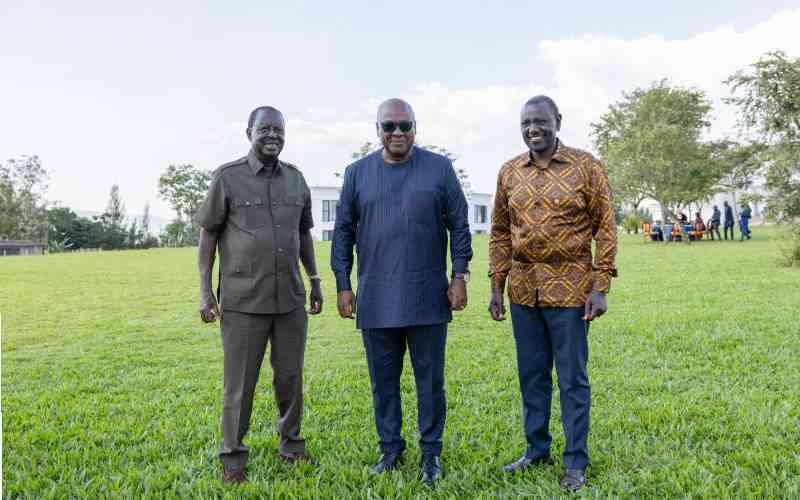The Sh12.7 billion proposed cement plant at Chasimba in Kilifi South sub-county has been met with sharp criticism with conservationists terming the project as environmentally disastrous.
The proposed project by Mashujaa Cement PLC, seeks to develop a cement-integrated plant at Pingilikani-Chonyi Area in Chasimba location that would manufacture clinker and Portland cement for commercial and other industrial use.
But conservationists have warned that the Environmental and Social Impact Assessment (ESIA) study report for the proposed project lacked comprehensive assessments and therefore posed a threat to the existence of rare species in an area they termed as 'ecologically sensitive'.
"The ESIA lacks full disclosure of the biodiversity values of the area. Under the Global Biodiversity Framework, all businesses must disclose their dependencies on biodiversity," Nature Kenya director, Paul Matiku said.
He adds that "The ESIA has ignored the biodiversity studies and stakeholder consultations that demonstrate that the Chasimba limestone area is irreplaceable."
In a letter addressed to the National Environmental and Management Authority Director General, Nature Kenya notes that setting the proposed clinker and Portland cement manufacturing plant at Chasimba will lead to the extinction of species only found within the area.
The organisation says that Chasimba is an ecologically sensitive area that has rare plants that are classified as critically endangered by the International Union for Conservation and Nature.
According to Nature Kenya, Chasimba site has more than 196 plant species of which 31 species are on the IUCN Red List, classified as Critically Endangered.
"Under the Convention on Biological Diversity, it is Kenya's obligation to protect all globally threatened species that occur in Kenya. For the African Violet sub-species, Kenya is solely responsible for guaranteeing to the world that this iconic plant is allowed to live and its extinction prevented," Matiku noted.
Although the ESIA outlined that the proposed project 'will negatively impact the few local vegetation' including scattered shrubs, cashew trees, and coconut trees, Nature Kenya criticized the report that it 'totally ignored the biodiversity studies and stakeholder consultations that demonstrate that the Chasimba limestone area is irreplaceable'
"The study report ensures that environmental and social concerns are integrated into the project's development and therefore ensure sustainable development," read part of the ESIA.
It added that, "It has covered and considered all environmental-related features and aspects. Notably identifying the potential environmental impacts associated with the proposed Mashujaa Cement Integrated Plant Pingilikani-Chonyi Area, Chasimba Location, Kilifi South Sub-County in Kilifi County Impact mitigation measures, and Environmental and Social Management Plans."
But Nature Kenya criticised the ESIA noting that it failed to recognise the presence of several species of rare plants on or near the project sites, listed as threatened with extinction in the IUCN Red List of Threatened Species.
Matiku said that the proposed limestone mine site which is the source of raw material targets the Chasimba and surrounding ecologically sensitive area which the ESIA has not considered its cultural significance of the rock outcrops and caves.
"The project is not sustainable as presented. In addition, the use of coal as an energy source adds to the global climate change and biodiversity loss crises. The project is ill-informed, ill-conceived, and environmentally untenable," Matiku wrote.
Stay informed. Subscribe to our newsletter
The area hosts a population of African Violet, currently classified as Critically endangered plant only found in Kenya. African Violets are found within the limestone outcrop crevices in Chasimba.
Chasimba is also home to endangered species that were recently discovered in 2020 and 2021.
And now conservationists argue that with its historical, cultural and outstanding universal values for humanity and tourism, Chasimba is a potential UNESCO Geo Park.
"Chasimba block and surrounding areas have a well-formed cave system that has taken millions of years to form by percolating ground and surface waters resulting to subterranean passages which display amazing formations such as the Kambe Limestone Belt," the letter read.
They argued that the ESIA management plan will not help the critically threatened biodiversity and unique caves and cultural values.
"The plan failed to capture Chasimba's threatened biodiversity," they say.
Among the planned mitigation measures for biodiversity outlined in the ESIA for the proposed plant included relocating some species to Arabuko-Sokoke Forest.
But Nature Kenya argues that the project has not demonstrated an understanding of the site or local population and any commitment to safeguard ecosystems or save species and their habitats.
"The ESIA indicates scientific unfamiliarity as it contains carelessly worded generic statements such as "species will be relocated to Arabuko Sokoke forest", or "the site is devoid of any eco-sensitive area", or "impact on biodiversity and wildlife is minimal". The experts ignored the threatened plants, geological features and cultural values of the Chasimba rock outcrops," Matiku noted.
The organisation called on Nema to stop mining activities in Chasimba and areas around it as they termed it as geologically and ecologically fragile
The organisation also called for comprehensive surveys of African Violet and other rare plants within the coastal region.
 The Standard Group Plc is a
multi-media organization with investments in media platforms spanning newspaper
print operations, television, radio broadcasting, digital and online services. The
Standard Group is recognized as a leading multi-media house in Kenya with a key
influence in matters of national and international interest.
The Standard Group Plc is a
multi-media organization with investments in media platforms spanning newspaper
print operations, television, radio broadcasting, digital and online services. The
Standard Group is recognized as a leading multi-media house in Kenya with a key
influence in matters of national and international interest.
 The Standard Group Plc is a
multi-media organization with investments in media platforms spanning newspaper
print operations, television, radio broadcasting, digital and online services. The
Standard Group is recognized as a leading multi-media house in Kenya with a key
influence in matters of national and international interest.
The Standard Group Plc is a
multi-media organization with investments in media platforms spanning newspaper
print operations, television, radio broadcasting, digital and online services. The
Standard Group is recognized as a leading multi-media house in Kenya with a key
influence in matters of national and international interest.




